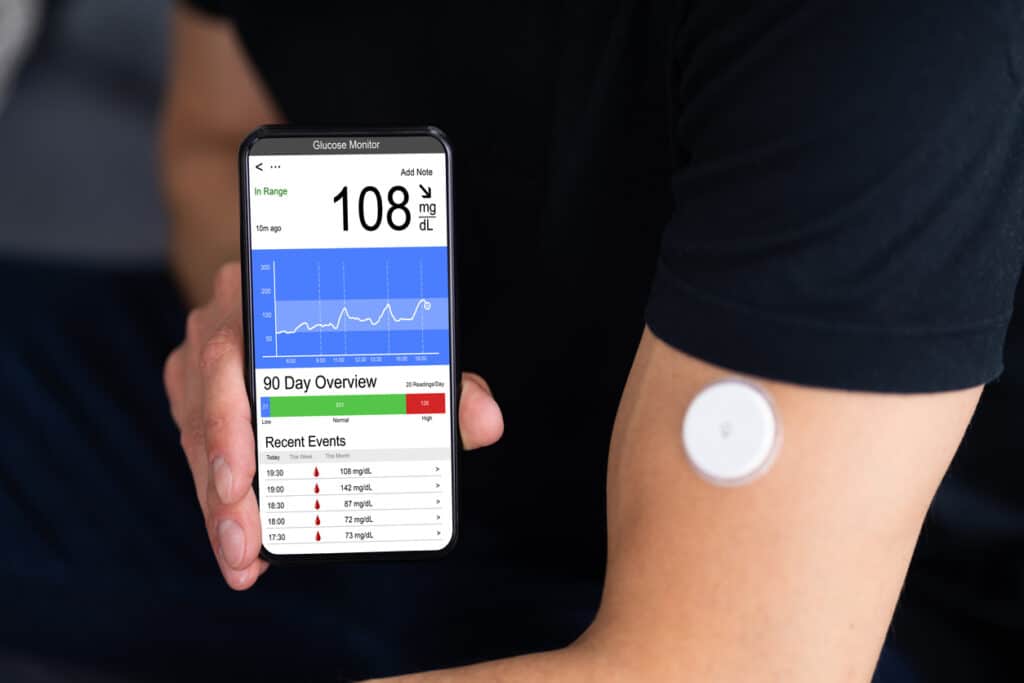Hype, science, and what healthy people need to know about CGM.
Why did CGM take off in the world of “wellness”?
Continuous glucose monitors (CGMs) have exploded in popularity thanks to influencers, wellness startups and biohacking apps. CGMs in non-diabetic patients are often sold as the next generation Fitbit of metabolism. We recommend unlocking personalized nutrition, fat burning potential, and real-time feedback to optimize your diet.
But here is the problem. CGM was developed for people with diabetes who track blood sugar. If you don’t have diabetes, does hitting your arm offer a real benefit, or is it just more data than you need?
What does “normal” blood sugar actually look like?
Normal fasting glucose levels range from 3.9 to 5.6 mmol/L or 70-100 mg/dL. It is normal to reach 7.8 mmol/L (140 mg/dL) as the body releases insulin and shuts down glucose to the cells. Two hours after eating, blood sugar levels should drop below 7.8 mmol/l or to 140 mg/dl

A large study called CGMAP (n>7,000 healthy adults aged 40-70) examined typical glucose levels in diabetes-free people in detail.
Average 24 hours glucose: ~5.5 mmol/L (99 mg/dL) time ≥7.8 mmol/L (140 mg/dL): <3% per day (approximately 20 minutes) overnight LOWS <3.9 mmol/L (70 mg/dl): Rare
That’s right – glucose spikes happen, especially after eating. However, these are normal and expected. In people with healthy metabolic functions, your pancreas will quickly clean its sugar and bring your levels back to baseline.
Human trials have not shown that these short-lived spikes in healthy people are harmful or increase the risk of illness.
Does CGM change the health behavior of healthy people?
Let’s break down what recent human exams have discovered.
huseatycgms doesn’t change your diet much
In the 2022 Crossover Study (PMID: 36279286), 15 healthy adults ate two equal-calf diets while wearing CGM. The device clearly detected higher spikes in a refined carbohydrate diet, but this did not lead to long-term dietary changes.
🏃 Exercise does not shift glucose in the way you expect
In the 2023 Canadian Study (PMID: 37562361), 27 sedentary adults wore CGMs and sat for 11 minutes of active exercises every day. The intervention groups became more appropriate, but their glucose was not upset. The mean glucose and blood glucose fluctuated did not change.
🕐TRE (time-limited meals) + CGMS = minor changes
2023 RCT (PMID: 37527388) studied diabetes-free, overweight adults. Participants had a time-limited meal (eating from 7am to 3pm) with a calorie deficit alone.
The TRE group had slightly smaller glucose spikes (∼0.3 mmol/L lower), but no changes in weight loss or average glucose.
Incorrectly interpret data in cgm data
A 2023 survey of non-diabetic CGM users (PMID: 37470511) said that most people checked their data frequently, but few people understood it. Some people have eliminated unnecessarily healthy carbohydrates.
“Using CGM outside of the clinical setting can lead to inappropriate dietary restrictions and increased food anxiety.” – Research authors
Conclusion: CGM does not promote better outcomes in already metabolically healthy individuals. They may backfire.
Are postmeal glucose spikes harmful?
No, and here it is:
After eating carbohydrates, glucose rises naturally. The pancreas releases insulin and cleans up sugar in the muscles and liver. This whole process is normal, temporary and not harmful to healthy people.
Spikes are part of the system and work correctly, rather than failing.
Studies in healthy individuals have shown that short increases in glucose after measurement (e.g., 120-140 mg/dL for 1 hour) are not associated with inflammation, oxidative stress, or long-term metabolic damage. Trying to flatten these small ascents often leads to extreme food avoidance and anxiety.
Cases of wearing diabetes-free CGM
Non-diabetics CGM – Can they help?
Perhaps – but only in very specific cases:
Screening of high-risk individuals (family history, PCOS, obesity) elite athletic performance (family history, PCOS, obesity).
However, for most people, lifestyle factors (eating, sleep, exercise, stress) have more impact than microcontrolling glucose per minute.
Conclusion: Probably no need for CGM
If you have no diabetes or diagnosed blood glucose disorders:
Your body handles glucose regulation on its own
Deative small spikes after meals are normal and harmless
❌CGM does not significantly improve health outcomes in healthy people
You may be overcorrected, over-limited, or stressed
Save your money and spend it on fiber-rich food, movements you enjoy, and good sleep hygiene. Simple ones are still best.





